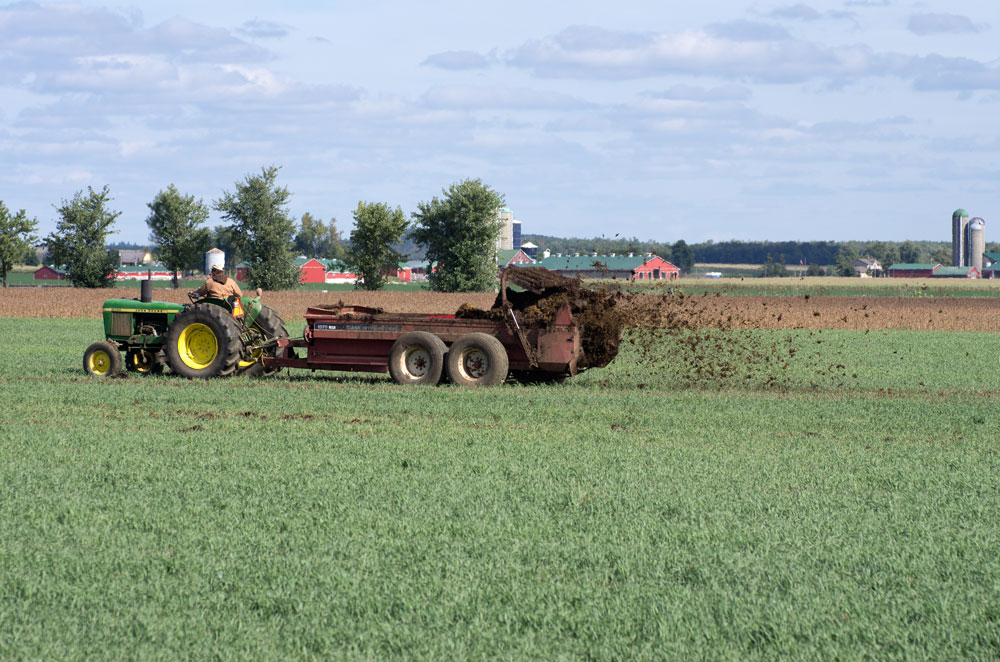
Manure management just be the bane of horse ownership. The U.S. Department of Agriculture states one horse produces 50 pounds of manure and urine per day. If you add used bedding to that equation, it’s a sizable amount of daily stall waste to deal with, which can cause chore inefficiency and unsightliness if not handled properly.
Living with manure can cause health problems for horses (e.g., parasite infestation), create excess dust in summer and mud in winter, and provide a breeding ground for insect pests. Additionally, manure is a potential source of nonpoint pollution if its runoff reaches ditches, creeks, ponds, or groundwater.
Here are four recommended best management practices (BMPs) for dealing with manure on horse properties.
Composting
For horse owners with pasture or cropland, composting is typically the No. 1 recommended manure management option. Before fertilizers were readily available and popularized, farmers composted livestock manure and food scraps and spread the finished product on pastures, crops, and gardens. Spreading fresh manure is not advisable because of the risk of spreading parasites, pathogens, and weed seeds, but spreading compost is excellent for soil health and pasture productivity.
Managing the composting process involves harnessing naturally occurring microorganisms to break down the stall waste. Monitoring the air and water in the compost pile will help you provide a suitable environment for microorganisms, which in turn generate the heat to kill parasites, pathogens, and weed seeds. To achieve a healthy microbial population, keep the pile aerobic (oxygenated) and somewhat damp. You can apply finished compost in a thin layer to pastures, lawns, gardens, and crops during the growing season. Compost is a rich soil amendment that adds life to soil and helps hold in moisture.
To implement this option, you will need a chore-efficient area in which to compost that’s big enough to accommodate the equipment you will be using. Make sure this area has easy access to the pastures or garden areas where you plan to use the finished compost.
Give Away Approach
Another BMP is to give away all manure and stall waste. This is particularly useful for small horse farms and works well in areas with gardening neighbors or landscape companies nearby. Barns in rural or agricultural locations might be able to find nearby crop farmers, plant nurseries, or topsoil businesses interested in picking up stall waste.
To implement this option, you will need a storage area in a chore-efficient location that’s convenient for stall cleaning chores as well as for those who’ll be picking it up regularly, such as along a driveway or farm road.
Hauling Off Property
Another option is hauling manure and stall waste off your property to a place that can utilize it. Don’t take it to a landfill—manure is a renewable resource and, like other recyclables such as paper or glass bottles, it should not take up valuable space in a landfill. Once set up, this option might require less energy and time on your part but will initially require some research and investigation. Sites that might take your manure include topsoil companies, composting facilities, crop farmers, or plant nurseries.
To implement this option, you will need equipment for hauling, such as a truck and dump trailer, and the means to get daily stall waste into the dump trailer (such as a dump ramp). Plus, these types of receiving sites usually charge a “tipping” fee, which can become expensive.
Reduce Stall Waste
The final BMP is to look at ways to reduce the amount of stall waste currently being generated by considering ways to reduce bedding use. This option represents a cost-savings for the facility owner because it means less waste by volume to manage, less cost for bedding, less storage area needed for bedding, and reduced environmental impacts by using fewer natural resources.
Consider using less bedding by applying only the amount needed for absorbing urine and moisture. Rubber stall mats are useful because the level stall floor makes it quick and easy to scoop out soiled bedding. Alternative beddings such as pelleted bedding or shredded newspaper offer greater absorbency and improved composability, reducing the amount of bedding required.
Mix and Match
In most situations, the best solution is going to be a combination of the BMPs above and might require creative thinking and research to come up with a workable option. Don’t be afraid to reach out to experts and government sources for help determining the best manure management solution for your farm.


